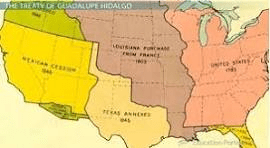True or false - slavery was illegal in the Union (the North) during the Civil War.
False - the "Border" states had slavery and stayed in the Union.
Who were "the Union"?
Who were "the Confederacy"?
The Union = The North
The Confederacy = The South
Why did Lincoln say "I have no purpose, directly or indirectly, to interfere with the institution of slavery in the States where it exists. I believe I have no lawful right to do so, and I have no inclination to do so." in his first inaugural address?
To calm the fears of the South
This compromise led to the "Kansas War" or "Bleeding Kansas"
The Kansas/Nebraska Act
What do we call it when you vote to decide something?
"Popular Sovereignty"
True or false - in 1800, there were no slaves in the Northern States (not counting the border states)
False - at that early date, nearly all of the Northern states had a small number of slaves.
Name three abolitionists.
- Sojourner Truth
-William Lloyd Garrison
- Harriet Tubman
- Frederick Douglass
- John Brown
What was Lincoln's priority at the beginning of the war - to preserve the Union or to end slavery?
To preserve the Union
** THIS CHANGED WITH THE EMANCIPATION PROCLAMATION**
If you wanted to identify a map of the Missouri Compromise, what line would you look for?
BONUS: Why was the line unsuccessful?
The 36'30 line
BONUS: It cut through California, which eventually wanted to join the Union as a free state.
TRUE - the violence it brought was a pre-cursor to the war
Why did slavery thrive in the South and not in the North?
The Plantation System - huge farms growing cash crops (crops to be sold, not eaten by the farmers) like cotton and tobacco developed in the South, which encouraged slavery.
This battle was the "highwater mark" for the South during the war.
What is Gettysburg?
What did the Emancipation Proclamation do?
It freed slaves in the rebelling states of the South.
**Did nothing for slaves in border states**
What is the name of the land acquisition that justified Manifest Destiny?
Hint: I'm not looking for the Louisiana Purchase
The Mexican Cession

Who was John Brown?
A violent abolitionist who killed 6 men in Kansas during the lead up to the vote on slavery.
He also led a failed slave revolt at Harpers Ferry, VA
The Compromise of 1850 had these two parts.
(a) The Fugitive Slave Act
(b) allowed California to enter as a Free State
** Destroyed the balance between slave and free states**
What did the Homestead Act do?
Gave 160 acres of land in the West to anyone who was 21 and could improve the land and live off it for 5 years.
****HELPED TO TAME THE WILDERNESS OF THE WEST****
What was one reason Abraham Lincoln issued the Emancipation Proclamation?
What reason did Judge Taney use to justify the Dred Scott decision?
He found that slaves were property, and that the Constitution did not allow the government to take a person's private property, therefore slavery could not be limited in the new territories (or anywhere, really)
Name three advantages the North had over the South during the war:
- More railroads
-More people
-More industry
Name three characteristics of slavery in the US
- Children of slaves became slaves, so it was generational
- Slaves could be (and often were) separated from their families by being sold away
- Slaves were not entitled to Constitutional protections (Dred Scott)
Lincoln's second inaugural address states:
""With malice toward none with charity for all with firmness in the right as God gives us to see the right let us strive on to finish the work we are in to bind up the nation's wounds, to care for him who shall have borne the battle and for his widow and his orphan ~ to do all which may achieve and cherish a just and lasting peace among ourselves and with all nations."
How would characterize how he wanted the South treated after the war.
He wanted them to be forgiven and quickly reentered into the Union.
What did the Fugitive Slave Act Do? What Compromise was it part of?
Fugitive Slave Act forced northern states to return slaves to the South who had escaped.
It was part of the Compromise of 1850.